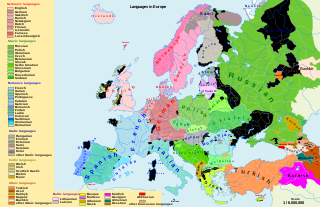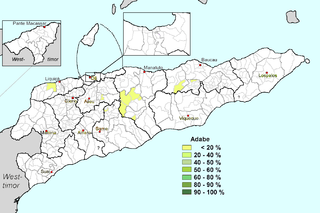Related Research Articles

There are over 250 languages indigenous to Europe, and most belong to the Indo-European language family. Out of a total European population of 744 million as of 2018, some 94% are native speakers of an Indo-European language. The three largest phyla of the Indo-European language family in Europe are Romance, Germanic, and Slavic; they have more than 200 million speakers each, and together account for close to 90% of Europeans.

Wetarese is an Austronesian language of Wetar, an island in the south Maluku, Indonesia, and of the nearby islands Liran and Atauro, the latter island separate from the mainland of East Timor, north of Dili.
Lola is an Austronesian language spoken on the Aru Islands of eastern Indonesia.
Omi is a Central Sudanic language, spoken in the Aru Territory, Orientale Province, Democratic Republic of the Congo, between the two rivers Nzoro and Lowa. It was once considered a dialect of the Keliko language, but requires separate literature.

The Santa Cruz language is the main language spoken on the island of Nendö or 'Santa Cruz', in the Solomon Islands.

The Kwasio language, also known as Ngumba / Mvumbo, Bujeba, and Gyele / Kola, is a language of Cameroon, spoken in the south along the coast and at the border with Equatorial Guinea by some 70,000 members of the Ngumba, Kwasio, Gyele and Mabi peoples. Many authors view Kwasio and the Gyele/Kola language as distinct. In the Ethnologue, the languages therefore receive different codes: Kwasio has the ISO 639-3 code nmg, while Gyele has the code gyi. The Kwasio, Ngumba, and Mabi are village farmers; the Gyele are nomadic Pygmy hunter-gatherers living in the rain forest.
Kula (Kola) or Lamtoka (Lantoka), also known as Tanglapui, is a Papuan language spoken in villages on the north coast, south coast and mountainous interior of Alor Island in Indonesia. Dialects are Kula proper, Kulatela, Watena, Kula Watena, Iramang, Larena, Sumang, and Arumaka. Most settlements where Kula is spoken are "new villages" that have only been inhabited since the 1960s. Due to this recent resettlement, and since usage of the language is discouraged in schools, Kula is an endangered language.
Barakai is one of the Aru languages, spoken by inhabitants of the Aru Islands.
Kele is a Bantu language of Gabon. Dialects of the Kele language are scattered throughout Gabon.

Itneg is a South-Central Cordilleran dialect continuum found in the island of Luzon, Philippines. This language and Ilocano are spoken by the Itneg people in Abra.

West Ambae is an Oceanic language spoken on Ambae, Vanuatu. Recognized dialects of West Ambae include Walaha and Nduindui (Duindui). The New Testament was published in West Ambae in 1984.
Manombai is one of the Aru languages, spoken by inhabitants of the Aru Islands, Indonesia.
Dobel, or Kobro’or, is one of the Aru languages, spoken by inhabitants of the Aru Islands Regency. It is close to Kola.
Tarangan is one of the Aru languages, spoken by inhabitants of the Aru Islands in eastern Indonesia. There are two varieties of Tarangan: East and West Tarangan. These varieties are divergent, perhaps no closer than they are to Manombai, also spoken in the Arus. West Tarangan is a trade language of the southern islands.
Batuley is a language spoken on the Aru Islands of eastern Indonesia. It is close to Mariri; Hughes (1987) estimates that around 80% of lexical items are shared. The language's name comes from the Gwatle island, which the Batuley consider their homeland.

Karey (Krei) is an Austronesian language spoken on the Aru Islands of eastern Indonesia.
Koba is a language spoken on the Aru Islands of eastern Indonesia. It is close to Dobel, though mutual comprehension is low.
Lorang is an Austronesian language of the Aru Islands in eastern Indonesia. It is spoken in one village on Koba Island.
Mariri (Mairiri) is an Austronesian language spoken on the Aru Islands of eastern Indonesia. It is close to Batuley.
Ujir is a language spoken on the Aru Islands of eastern Indonesia, spoken in the villages of Ujir and Samang in northwestern Aru. As of 2015, it is highly endangered, since it is only spoken by a small fraction of the population of the two villages.
References
- ↑ Kola at Ethnologue (18th ed., 2015) (subscription required)
Kompane at Ethnologue (18th ed., 2015) (subscription required)